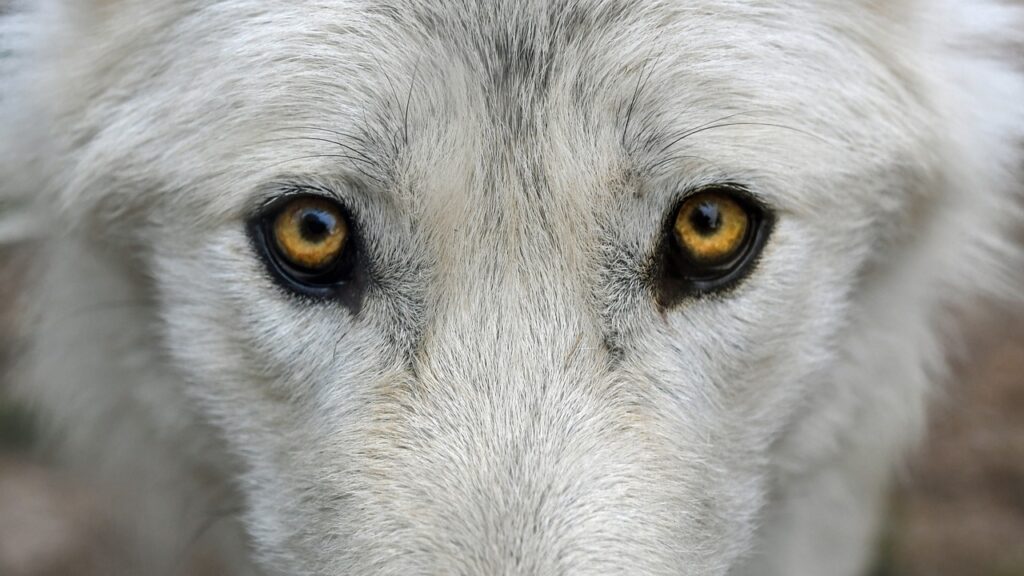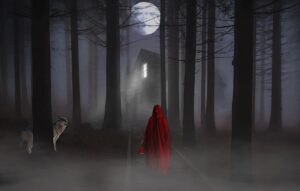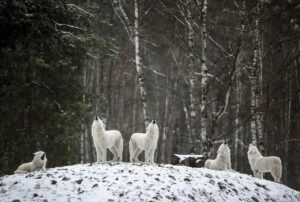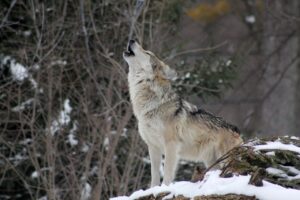A Letter to an Old Friend: Dear Gray Wolf

Dear Gray Wolf,
I’ve been worrying about you lately. I hear you’ve been going through some rough times, that the past few years have been turbulent and dangerous and persistently mean and hideous. Your plight has haunted me for decades, since long before the current trouble. Conservationists have to fight the same battles over and over, because a species is gone forever once wiped out, but, once saved it has to be saved again and again, because destroyers return to do mischief with the persistence of leeches.
Do you remember, oh, a good 40 years ago, when there were only about 1,000 of you in the USA south of the border with Canada, all or almost all in Minnesota? I do. I remember it well. In the ‘60s, when I was a college-undergrad zoology major, I wanted to study wolves. Never got the chance, but I did keep up on news regarding wolves, and, when I moved to Washington, D.C., in 1982, I was very happy to be working for one of the great wolf advocates, Defenders of Wildlife. I worked on the magazine staff with hopes of stimulating support for wolf recovery. I felt as if I were breathing fresh air for the first time.
An Uphill Struggle for Endangered Species
Trying to restore wolves was a tough battle. North American wolves had been treated as vermin as soon as Europeans arrived in the New World. The idea that wolves were vermin (sorry) was a concept older than the pyramids, probably dating to the days of the first livestock herders. Stories like the one about you and Little Red Riding Hood didn’t help your case any. The idea of preserving wolves, of conserving them, restoring them, protecting them was simply not an idea that human society could conceive of, as you well know. Your kind were ducking the slings and arrows, and later the poisons and bullets, of lethal misfortune as far back as anyone could remember.

Wolves at Risk
You were easy to wipe out, living as you do in packs composed of pups, parents, and earlier offspring. Your size and numbers made you easy to spot. It also didn’t help that you—meaning your ancestors—would crowd around any humans who offered the remotest chance of an easy meal. For example, when 19th century hide hunters were killing bison almost to the last animal on western prairies, you’d form circles around buffalo skinners up to their elbows in blood and reeking with the stench of death as they hacked away. Oh yes, there you were, waiting patiently, sitting on your haunches, licking your chops—easy pickings for the rifles that slaughtered bison. And slaughtered elk. And wild sheep. And deer. And bears. And so it went.
And when the wild game you hunted was gone, well, you were flexible, you turned to hunting the White Man’s buffalo: cattle. T’was do that or starve. The hide hunters were flexible too. With bison gone, the hunters turned into wolf bounty hunters, killing you with traps, snares, and poison baits in hope of collecting blood money from ranchers and state governments. And die you did. Even in national parks, into the 1920s, you were poisoned and blasted away to the last animal. QUOTES

You survived in the Lower 48 only in remote regions of the Great Lakes: those 1,000 wolves, all or almost all in northern Minnesota. But groups like Defenders and the National Audubon Society were adopting new ideas about wolves. These ideas were starting to develop in the 1920s among early biologists who had the skills, knowledge, and intelligence to sense that killing off predators was a fool’s errand. An ecosystem is an intricate dance of species, and removing species invites the collapse of the whole show. An inspired biologist named George Wright, working for the National Park Service in the ’20s and ’30s as a top-level biologist, urged the cessation of predator control in the parks.
So did Aldo Leopold, one of the great conservation thinkers of the past century, who concluded that with wolves, an ecocystem would be eaten into the ground by deer, elk, and other plant eaters.
Changing Values for Wolves
The late ‘60s and early ‘70s saw the rise of federal legislation designed to protect and recover species in danger of extinction. As you know, the Endangered Species Act of 1973, under which you were listed (the first truly effective federal legislation for endangered species recovery, signed into law by President Richard Nixon—whodda guessed?), required the U.S. Fish and Wildlife Service to designate and protect habitat critical for endangered terrestrial species, but the agency often neglected to designate critical habitat and even failed at times to list certain vanishing species, which led to a lot of lawsuits. You were lucky. A bunch of groups went to work in the ‘80s to get your kind restored to areas where they had been wiped out—first and foremost, Yellowstone National Park. This plan was helped along when wolves, on their own, slipped out of Canada into the Glacier National Park area in northwestern Montana, stoking great encouragement among conservationists.
Wolf Restoration Begins
After much legal drama, many political skirmishes, and a hefty amount of federal cooperation, wolves captured in Canada were shipped to Yellowstone in Wyoming and released in 1995. Until then, you were the park’s only native species that was missing, and your return made Yellowstone one of the few complete ecosystems in the USA—as the elk and deer soon noticed, chomp chomp. So did park visitors, who reveled in seeing wolves hunting in the Lamar Valley and who bought up tons of souvenirs featuring wolves, wolves, and more wolves.
In the glow of this success, other restoration programs got under way, plus wolves started doing their own restoration, moving from Wyoming, Montana, and Minnesota into other states, reclaiming lost territory. Did they sometimes kill livestock? Sadly, you know darn well that some of you did. But Defenders started a program that reimbursed ranchers who lost livestock to wolves, and federal biologists sometimes removed wolves that showed a pattern of killing livestock. I know, that upsets you, but hey, look at the bright side—we now have wolf populations in nearly a dozen states.
The Trouble Begins for Wolves
Well, there’s always trouble for wolves. As you know all too well, some of you are illegally assassinated and quietly buried so conservation officials know nothing it. But it gets worse. Under federal protection, you guys have done so well that the Fish and Wildlife Service decided to delist you. The agency started with Idaho and Montana in 2011, and Wyoming in 2017, before delisting the gray wolf completely in 2021 south of the border with Canada, retaining protection only for Mexican gray wolves being released by the Service and other entities in New Mexico and Arizona. No more endangered species protection. No more federal protection. Management turned over to the states.
You’d think that by now, state governments would have incorporated the knowledge gained about wolves and other predators in, lo, these past 100 years and more. Okay, maybe you and yours would know better than to believe anything so hopeful, but some people did. And they were wrong. Delist you and your pals and bam!, as you’ve probably noticed, state governments start falling all over themselves in their haste to shoot, poison, trap, ensnare, and in any other way kill wolves. A lot of people have guns and see every animal as food or foe and well, they want to shoot something. You’ll do.
Some figures. During the first 63 hours of a state-run wolf hunt in Wisconsin, 216 wolves were killed, exceeding the limit of 119 that the state had set. The wolf population soon dropped from 1,126 to 972, a decline of 14 percent. Montana set a limit of 450 wolves killed in its first open season, which would put a big dip in a population of only 800 to 1,200 wolves. You and your kith and kin struggle on, some 7,500 of you in the Lower 48, with northern gray wolf populations in around nine states, almost entirely in the West and north of the Great Lakes, as well as transient, mostly individual wolves drifting here and there across states from North Dakota to New York. Meanwhile, conservation groups are fighting in court and Congress to get you relisted and reprotected.

Can We Continue to Protect and Restore Wolves
What’ll it take to reverse course? Well, relisting you as threatened or endangered would help. But what you really need are vocal advocates who will speak on your behalf, and who will vote to throw out of office those who want to revive the old road to death and destruction. Which, by the way, isn’t limited to killing you and yours. You’re trap-wielding enemies are elated to kill bears and coyotes, mountain lions and prairie dogs (because prairie dogs “compete” with cattle for grass). And the government obliges, killing and killing. The U.S. Department of Agriculture’s Wildlife Services, which “serves” wildlife by slaughtering it at the behest of the agricultural industry, fish farms, and other businesses, killed more than 400,000 native wild animals in 2021. In 2022, among predators alone, the program accounted for 56,089 coyotes, 2,432 foxes, 515 bobcats, 450 black bears, 219 gray wolves, 205 mountain lions, and 7 grizzly bears, a federally protected species. Here’s the weirdest rub of all: if this program were effective and wiped out these species, the species would have to be listed as threatened or endangered and managed under a recovery program. Is human intelligence an oxymoron? Well, someone is moronic.
A pity that wolves, and bears, and badgers, and bison, and so on can’t vote. We have to count on people, people who are outraged by the continued waste, disruption, and desecration of nature and who will throw the minions of murder out of office. Well, yes, I know . . . but if we don’t get this support, we might as well be howling at the moon.
You know what I mean. Nevertheless, all the best to you and yours.
Roger